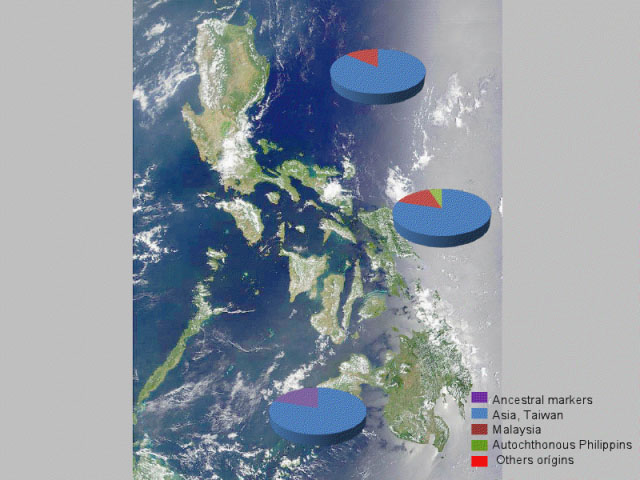Filtered by: Lifestyle
Lifestyle
The semantics of 'mestizo'
By AMANDA LAGO, GMA NEWS
“What’s your mix?” clothing brand Bayo asked Filipina women in its heavily-lampooned ad campaign from last month.
The ad drew criticism for excluding 100-percent Filipinos, and glorifying the “50-precent Filipina” instead, thereby feeding the beauty industry's obsession with so-called mestizas.
But as it turns out, all Filipinos are mestizos of a sort—and it comes down to matter of semantics.
Apparently, the word “mestizo” has long suffered from widespread misuse, at least according to cultural anthropologist Dr. Fernando Zialcita. To most Filipinos, “mestizo” refers to fellow Pinoys who are fairer-skinned than others, usually those who are descended from American or European parents or grandparents.
But in a lecture at the Instituto Cervantes Tuesday, Zialcita said that the original meaning of the word “mestizo” has nothing to do with skin color.
“Today of course when you use the term ‘mestizo’ in the Philippines, you tend to think of somebody who looks white. But originally that was not the way it was used in the Philippines because in the Spanish period, ‘mestizo’ was also used for Chinese-Filipinos. Mestizo de Sangley, for instance,” Zialcita shared.
The anthropologist explained that “mestizo” is a Spanish word derived from the Latin, “mixtus,” so it can therefore refer to anyone who is of mixed origins—and in the Philippines, that means almost everyone.
“Mestizo can be a mixture of anything. It can be Ibanag with Ifugao, or Maranao with Spaniard, or Maranao with Chinese,” Zialcita said.
“It’s a mixture, but we have tended to narrow it too much today to just somebody with Spanish blood, which is very erroneous,” he added.
Zialcita said that when used in that context, “mestizo” becomes a more desirable term to refer to people of mixed origins because it suggests a complete fusion, as opposed to terms like “half-breed,” or “hybrid,” which connote division.
Cultural mestizos
Zialcita added that "mestizo" could even refer to a cultural as well as a biological mixing.
“One thing we should also consider is that being mestizo is a biological and a cultural feeling,” Zialcita pointed out.
He gave the example of Malaccan Portuguese of Malaysia, who, despite being physically different from their European counterparts, still identify as one of them because they share the same religion and cultural practices.
"Mixing is common. It is normal for humans to mix. There’s a problem that there is this myth, for example that the Japanese culture is “pure,” if you look at it historically, that is not the truth, because cultures like to mix," he said. 

Dr. Gonzalez-Martin's initial results show that the Philippine population consists of a major genetic contribution from Taiwan and a smaller contribution from Malaysia. Photo from Antonio Gonzalez-Martin.
Genetic mestizos
Zialcita’s talk came at the heels of Spanish biologist Antonio Gonzalez-Martin’s presentation where the scientist revealed the preliminary findings of his study, which aims to determine the genetic map of the Philippines.
During his presentation, Gonzalez-Martin confirmed that Filipinos are indeed a genetic mix of several ethnicities, anchoring a widespread belief to scientific and historical data.
Gonzalez-Martin shared that based on his study of 47 skull samples and 100 saliva samples from all over the country and Madrid, Taiwanese and Malay roots are the most evident in the mitochondrial DNA of Filipinos.
However, Gonzalez-Martin noted he cannot as yet quantify what percentage of the average Filipino’s genes originated from which specific race, saying that the differences between the genes are very small and hard to determine.
“Part of the origin of the population in the Philippines are from Taiwan, part are from Malaysia, but we cannot interpret this information about the ‘closest race,’ because there is very little variation,” Gonzalez-Martin said.
“We are the same, all the population in the world is the same. There is little difference,” he added.
In the results he presented, there was a curious absence of Spanish or European origins, though Gonzalez-Martin stressed that the results are only preliminary findings and are therefore inconclusive.
He explained that the mitochondrial DNA he studied only represents traits inherited from the mother.
“In the future, we want to study other genetic markers,” he said.
“The history of the women and the men are different. For example, in the time of the expansion of the Europeans, the high percentage of the people that moved were men, not women,” Gonzalez-Martin noted.
The biologist said that he chose to study the Philippines because “aside from the fact that the Philippines has an extremely rich demographic history, these islands are key to explain the expansion of human beings in the Austronesian region.”
However, throughout his presentation, he constantly underlined the homogenous nature of the human race, saying that because of widespread cultural and biological mixing, categorical races are harder and harder to determine, especially since there are very little differences between races to begin with.
“Biologists and geneticists do not like to say that there is race…race has been linked to dramatic and dark moments in our recent history. We try to prove that from a genetic point of view, races do not exist in the 21st century,” Gonzalez-Martin said. –KG, GMA News
More Videos
Most Popular




